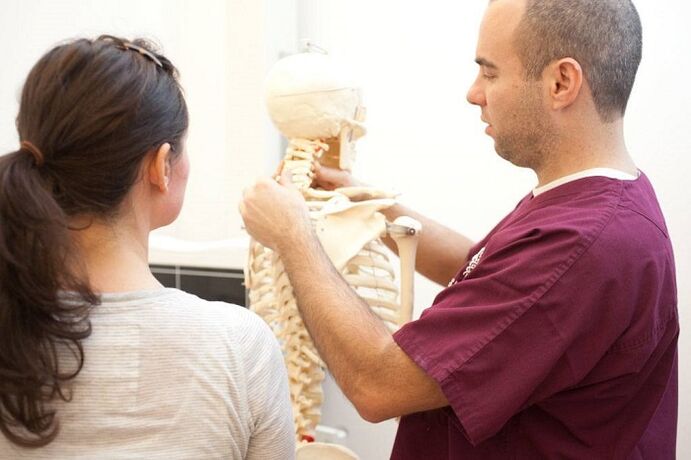Osteochondrosis of the cervical spine belongs to the category of long -term chronic diseases. In the process of disease progression, destruction of the intervertebral space occurs, which, if left untreated, inevitably leads to the formation of herniated discs. In the modern world, the elderly and children suffer from osteochondrosis. At the same time, the healing process is delayed for months, or even years, and does not always guarantee a positive result. Therefore, this problem should be addressed seriously, because the sooner the doctor can determine the presence of cervical osteochondrosis and prescribe treatment, the more likely the patient should restore his health.

The disease in question has a rather special manifestation, so it is difficult not to notice it. However, before considering information on how to determine cervical osteochondrosis, it is necessary to know what its symptoms are and the factors responsible for its occurrence.
Osteochondrosis is a chronic disease that causes the onset of degenerative processes in the connective cartilage tissue located between individual vertebrae. The development of this disease interferes with the normal functioning of the body and can lead to disability. At the same time, the destructive process causes inflammation, which spreads to nearby nerve fibers. The development of this event causes muscle spasms, which are excessive, trying to prevent the occurrence of rupture of blood vessels and nerve roots.
However, without external intervention, the body cannot cope with the disease and, as a consequence, a decrease in the gap between individual vertebrae, along with other consequences of osteochondrosis, will cause significant difficulties in blood circulation, and the human brain will not receive essential oxygen and nutrients. in the required quantity. Naturally, this will immediately affect the patient’s self -awareness, therefore, osteochondrosis can be determined by a number of characteristic symptoms.
The main symptoms
The most common symptoms are:
- persistent pain in the neck and head;
- frequent nausea, sometimes vomiting;
- strong and sudden changes in blood pressure;
- dizziness, fainting.
As you can see, the symptoms are quite specific and it is impossible not to notice them, therefore, it is not difficult to determine osteochondrosis in the neck area. However, only an experienced neurologist should make a diagnosis, as the disease affects many functions and during the examination, an accurate picture of what is going on should be made to prescribe the most effective treatment.

To determine the nature of the course of cervical vertebral osteochondrosis, the patient was sent for X-rays and computed tomography. In some cases, an ultrasound scan may be prescribed. As a rule, this occurs with complaints of chest pain with a background of absent cardiac pathology.
Manifestations of heart disease in patients with osteochondrosis in the neck indicate the active spread of the disease along the spine. Symptoms like these are rare, so a neurologist will definitely send the patient in advance for an examination to a cardiologist, who must identify the heart problem or confirm its absence. If the work of the cardiac system takes place without interruption, then there is nothing to worry about, because osteochondrosis itself does not affect the activity of vital organs such as the heart.
The above symptoms appear from the first weeks of the onset of the disease. The only exceptions are dizziness and nausea, as these unpleasant sensations are present in patients at stage 2-3 of the development of the disease.
In total, there are three stages of development of the disease, the third manifests itself in the most dangerous way. If you do not treat osteochondrosis of the cervical spine, then its transition to a severe form will lead to disruption of the normal functioning of many vital systems of the human body.
Prerequisites for the appearance of osteochondrosis
There are many factors that are considered manifestations of spinal osteochondrosis in the neck. However, the main one is incorrect spinal posture. Therefore, it is very important to establish some habits to maintain proper body position while working and resting since childhood.
The second very significant factor is called an inactive lifestyle. Modern people usually complain about the lack of time for sports, but at the same time he can spend a lot of time surfing the Internet waves without thinking, empty communication on social networks or computer games.

Since childhood, most people have reported great benefits of moderate morning exercise. Even so, not many modern people do it, although a simple physical exercise in the morning can stimulate blood circulation, experience real joy and help create a good mood throughout the day. In addition, morning exercise will keep your joints healthy and moving for years to come.
The last serious factor that causes spinal osteochondrosis in the neck area, and at the same time many other problems, is vitamin deficiency. Usually, the human body lacks vitamins in winter and early spring, so during this period you should eat as much as possible raw vegetables and fruits or buy vitamin complexes sold in any pharmacy. You must also pay attention to other micro elements that are important for the body. By the way, many people mistakenly believe that osteochondrosis appears due to a lack of calcium. This is not the case, although calcium should be used in the treatment of this disease, as it induces rapid healing of cartilage tissue.
The main stage of osteochondrosis
- First.In the early stages, a dull pain appears, which quickly disappears if a person lets his body rest for a while. Also, patients may notice a spike in blood pressure, which is the first sign of brain oxygen starvation.
- Second.The next stage has darkened the usual way of life, as the pain syndrome in the neck becomes quite strong and does not always disappear even after taking analgesics. This makes a person very irritable, which affects his attitude towards others negatively. In addition, there is a constant feeling of fatigue, systematic headaches appear.
- Third.The last rank is considered the most dangerous. Patients experience intolerable pain in the neck and head, which cannot even be overcome by strong painkillers. Dizziness, nausea also appear, his movement is limited, and so on.
As you can see, osteochondrosis has a fairly obvious symptomology, however, in the early stages, many people ignore the signs of impending disaster. It is very important to be vigilant and timely identify the disease that is already present at its first weak manifestation.
As a rule, neuropathologist patients are people whose osteochondrosis has reached the second stage of its development. This complicates the healing process, as it can fight the disease effectively only in the early stages.

Do not forget that osteochondrosis is one of the most difficult back diseases. It can have a negative impact on the work of several important systems at once. If you do not seek timely professional help, then, as a consequence, you can start a disease that will lead to the formation of a spinal hernia, in which only surgical intervention will correct the situation.
The recovery process in osteochondrosis is delayed for a long time and can be successful only by adhering to all doctor’s prescriptions. You cannot diagnose and prescribe treatment independently, as you can make the condition worse.
Many believe that osteochondrosis is the last resort and it is impossible to fully recover from it. In fact, this is not the case at all if the disease has not yet reached the final stages of development. In other cases, the situation can be improved, but for this you need to focus on hard and long work, and, in addition, you should change your lifestyle, making sports and outdoor activities an important part of it.

























